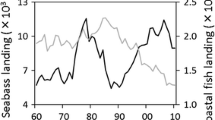Abstract
The embryonic drift pattern of amphidromous Rhinogobius species varies along river courses. It peaks soon after sunset in reaches with gentle gradient on the plains, whereas it occurs throughout the day in steep reaches. Examination of the size of the sagittal otolith and notochord length indicated that the age of embryos drifting in steep reaches varied widely, ranging from 0 to 7 days. Many had exhausted their yolk. We attributed the all-day drift in steep reaches to retention of drifting embryos in slack waters or eddies near the banks. In contrast, most embryos drifting in reaches with gentle gradients were recently-hatched individuals. We estimated that in normal or low river flow most embryos from the upstream reaches perish through starvation before they reach the sea.
Similar content being viewed by others
References cited
Balon, E.K. 1990. Epigenesis of an epigencticist: the development of some alternative concepts on the early ontogeny and evolution of fishes. Guelph Ichthyol. Rev. 1: 1–42.
Balon, E.K. M.N. Bruton. 1994. Fishes of the Tatinga River, Comoros, with comments on freshwater amphidromy in the goby Sicyopterus lagocephalus. Ichthyol Explor. Freshwaters 5: 25–40.
Blaxter, J.H.S. G. Hempel. 1963. The influence of egg size on herring larvae (Clupea harengus L.). J. Cons. Perm. Int. Explor. Mer. 28: 211–240.
Brothers, E.B. 1981. What can otolith microstructure tell us about daily and subdaily events in the early life history of fish? Rapp. P-V. Reun. Cons. Int. Explor. Mer. 178: 393–394.
Campana, S.E. 1983a. Feeding periodicity and the production of daily growth increments in the otoliths of steelhead trout (Salmo gairdneri) and starry flounder (Platichthys stellatus). Can. J. Zool. 61: 1591–1597.
Campana, S.F. 1983b. Calcium deposition and otolith check formation during periods of stress in coho salmon, Oncorhynchus kisutch. Comp. Biochem. Physiol. 75A: 215–300.
Campana, S.E. J.D. Neilson. 1985. Microstructure of fish otoliths. Can. J. Fish. Aquat. Sci. 42: 1014–1032.
Dotu, Y. 1955. The life history of goby, Chaenogobius urotaenia (Hilgendorf). Sci. Bull. Agr. Kyushu Univ. 15: 367–374. (in Japanese).
Dotu, Y. 1961. The binomics and life history of the gobioid fish, Rhinogobius giurinus (Rutter). Bull. Fac. Fish. Nagasaki Univ. 10: 120–126. (in Japanese).
Dotu, Y. S. Mito. 1955. Life history of a gobioid fish, Sicydium japonicus Tanaka. Sci. Bull. Agr. Kyushu Univ. 15: 213–221. (in Japanese).
Goto, A. 1986. Movement and population size of the river sculpin, Cottus hangiongensis in the Daitobetsu River of southern Hokkaido. Japan. J. Ichthyol. 32: 421–430.
Goto, A. 1988. Reproductive behavior and homing after down stream spawning migration in the river sculpin, Cottus hangiongensis. Japan. J. Ichthyol. 34: 488–496.
Iguchi, K. N. Mizuno. 1990. Diel changes of larval drift among amphidromous gobies in Japan, especially Rhinogobius brunneus. J. Fish Biol. 37: 255–264.
Iguchi, K. N. Mizuno. 1991. Mechanisms of embryonic drift in the amphidremous goby, Rhinogobius brunncus. Env. Biol. Fish. 31: 295–300.
Iguchi, K. M. Yamaguchi. 1994. Adaptive significance of inter and intra-populational egg size variation in ayn Plecoglassus altivelis (Osmeridac). Copeia 1994: 184–190.
Kani, T. 1944. Ecology of torrent-inhabiting insects, pp. 171–317. In: H. Furukawa (ed.) Insects 1, Kenku-sha Press, Tokyo, (in Japanese).
Kawanabe, H. N. Mizuno (ed.). 1989. Freshwater fishes of Japan. Yamatokcikoku-sha Press, Tokyo, 719 pp. (in Japanese).
Marshall, S.L. S.S. Parker. 1982. Pattern identification in the microstructure of sockeye salmon (Oncorhynchus nerka) otoliths. Can. J. Fish. Aquat. Sci. 39: 542–547.
Masuda, Y., T. Ozawa S. Enami. 1989. Genetic differentiation among eight color types of the freshwater goby, Rhinogobius brunneus, from western Japan. Japan. J. Ichthyol. 36: 30–41.
Mizuno, N. 1960. Study on a freshwater goby, Rhinogoblus similus Gill, with a proposition on the relationships between land-locking and speciation of some freshwater gobies in Japan. Mem. Coll. Sci. Univ. Kyoto Ser. B 27: 97–115.
Mizuno, N. 1976. Study of a freshwater goby, Rhinogoblus brunneus (Pisces: Gobiidae), III. Distribution of four colour types in Shikoku and Kyushu Islands. Physiol. Ecol. Japan 17: 373–381. (in Japanese).
Mizuno, N. H. Kawanabe. 1981. A topographical classification of streams, with an introduction of the system widely used in Japan. I. Reach type, stream zone and stream type. Verh. internat. Verein Limnol. 2: 913.
Mizuno, N., S. Uchara M. Maki 1979. Studies on the freshwater fish, Rhinogobius brunneus (Gobiidae). IV. Habitat segregation among sympatric populations of 4 colour types. Japan, J. Ecol. 29: 137–147. (in Japanese).
Moss, B. 1980. Ecology of fresh waters. Blackwell, Oxford. 332 pp.
Shitaishi, Y. N. Suzuki. 1962. The spawning activity of ayu-fish, Plecoglossus altivelis. Bull. Freshw. Fish. Res. Lab. 12: 84–107. (in Japanese).
Tamada, K. 1986. Size variations of a freshwater goby, Rhinogo bws brunneus, crossband type, along the river length in terms of age and growth. The Nanki Seibutu 28: 23–34. (in Japanese).
Tsukamoto, K. 1991. Age and growth of ayu larvae Plecoglossus altivelis collected in the Nagara, Kiso and Tone River during the downstream migration. Nippon Suisan Gakkaishi 57: 2013–2022. (in Japanese).
Tsukamoto, K. T. Kajihara. 1987. Age determination of ayu with otolith. Nippon Suisan Gakkaishi 53: 1985–1997.
Ware, D.M. 1975. Relation between egg size, growth, and natural mortality of larval fish. J. Fish. Res. Board Can. 32: 2503–2512.
Author information
Authors and Affiliations
Rights and permissions
About this article
Cite this article
Moriyama, A., Yanagisawa, Y., Mizuno, N. et al. Starvation of drifting goby larvae due to retention of free embryos in upstream reaches. Environmental Biology of Fishes 52, 321–329 (1998). https://doi.org/10.1023/A:1007333302864
Issue Date:
DOI: https://doi.org/10.1023/A:1007333302864




